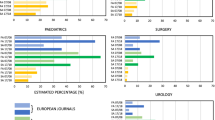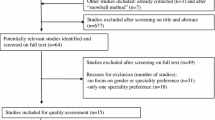Abstract
This study aimed to assess differences in the percentage of illustrations showing males versus females in textbooks of general medicine and general surgery, two areas that constitute a focus of the traditional medical school curriculum. Illustrations showing 3447 individuals and/or external body parts from all general medicine (n = 13) and general surgery (n = 2) books listed in the “essential purchase titles” section of Doody’s Core Titles list (2013) were assessed. Sex was determined based on depictions of faces, chests, and the genital region. One thousand one hundred fifty-three individuals and/or external body parts could be clearly identified as either male (58.28 %) or female (41.72 %), yielding a difference of 16.57 %. The difference in the percentage of identifiable males and females depicted was smaller in general surgery books (6.43 %) as compared to general medicine texts (20.84 %). Differences were noted in the percentage of male and female body parts shown by anatomical site. Of all faces that could be clearly identified as either male or female, 78.04 % were male, while 21.96 % were female. By contrast, 55.93 % of genital regions that could be classed as either male or female showed men, while 44.07 % showed women. These results suggest that illustrations in medical textbooks may continue to depict more males than females. Students may have more exposure to illustrations of the male than the female body during their training.


Similar content being viewed by others
References
Angell M. Caring for women’s health—what is the problem? N Engl J Med. 1993;329:271–2.
Council on Ethical and Judicial Affairs, American Medical Association. Gender disparities in clinical decision making. JAMA. 1991;266:559–62.
Mendelsohn KD, Nieman LZ, Isaacs K, Lee S, Levison SP. Sex and gender bias in anatomy and physical diagnosis text illustrations. JAMA. 1994;272:1267–70.
Freedman LS, Simon R, Foulkes MA, Friedman L, Geller NL, Gordon DJ, et al. Inclusion of women and minorities in clinical trials and the NIH Revitalization Act of 1993—the perspective of NIH clinical trialists. Control Clin Trials. 1995;16:277–85.
Meisel ZF, Armstrong K, Crawford CC, Shofer FS, Peacock N, Facenda K, et al. Influence of sex on the out-of-hospital management of chest pain. Acad Emerg Med. 2010;17:80–7.
Vaccarino V, Rathore SS, Wenger NK, Frederick PD, Abramson JL, Barron HV, et al. Sex and racial differences in the management of acute myocardial infarction, 1994 through 2002. N Engl J Med. 2005;353:671–82.
Blomkalns AL, Chen AY, Hochman JS, Peterson ED, Trynosky K, Diercks DB, et al. Gender disparities in the diagnosis and treatment of non-ST-segment elevation acute coronary syndromes: large-scale observations from the CRUSADE (Can Rapid Risk Stratification of Unstable Angina Patients Suppress Adverse Outcomes With Early Implementation of the American College of Cardiology/American Heart Association Guidelines) National Quality Improvement Initiative. J Am Coll Cardiol. 2006;45:832–7.
Tavris D, Shoaibi A, Chen AY, Uchida T, Roe MT, Chen J. Gender differences in the treatment of non-ST segment elevation myocardial infarction. Clin Cardiol. 2010;33:99–103.
Keyhani S, Scobie JV, Hebert PL, McLaughlin MA. Gender disparities in blood pressure control and cardiovascular care in a national sample of ambulatory care visits. Hypertension. 2008;51:1149–55.
Hawker GA, Wright JG, Coyte PC, Williams I, Harvey B, Glazier R, et al. Differences between men and women in the rate of use of hip and knee arthroplasty. N Engl J Med. 2000;342:1016–22.
Gebo KA, Fleishman JA, Conviser R, Reilly E, Korthius PT, Moore RD, et al. Racial and gender disparities in receipt of highly active antiretroviral therapy persist in a multistate sample of HIV patients in 2001. J Acquir Immune Defic Syndr. 2005;38:96–103.
Mocroft A, Gill MJ, Davidson W, Phillips AN. Are there gender differences in starting protease inhibitors, HAART, and disease progression despite equal access to care? J Acquir Immune Defic Syndr. 2000;24:475–82.
Alexanderson K, Wingren G, Rosdahl I. Gender analysis of medical textbooks on dermatology, epidemiology, occupational medicine and public health. Educ Health. 1998;11:151–63.
Dijkstra AJ, Verdonk P, Lagro-Janssen ALM. Gender bias in medical textbooks: examples from coronary heart disease, depression, alcohol abuse and pharmacology. Med Educ. 2008;42:1021–8.
Lawrence SC, Bendixen K. His and hers: male and female anatomy in anatomy texts for U.S. medical students, 1890–1989. Soc Sci Med. 1992;35:925–34.
Giacomini M, Rozée-Koker P, Pepitone-Arreola-Rockwell F. Gender bias in human anatomy textbook illustrations. Psychol Women Q. 1986;10:413–9.
Morgan S, Plaisant O, Lignier B, Moxham BJ. Sexism and anatomy, as discerned in textbooks and as perceived by medical students at Cardiff University and University of Paris Descartes. J Anat. 2014;224:352–65.
Doody’s Core Titles, 2013 edition. Available from: www.doody.com
Shedlock J, Walton LJ. Developing a virtual community for health sciences library book selection: Doody’s Core Titles. J Med Libr Assoc. 2006;94:61–6.
Gesensway D. Reasons for sex-specific and gender-specific study of health topics. Ann Intern Med. 2001;135:935–8.
Phillips SP. Defining and measuring gender: a social determinant of health whose time has come. Int J Equity Health. 2005;4:11.
Author information
Authors and Affiliations
Corresponding author
Rights and permissions
About this article
Cite this article
Murciano-Goroff, Y.R. Differences in the Percentage of Illustrations Showing Males Versus Females in General Medicine and General Surgery Textbooks. Med.Sci.Educ. 25, 123–126 (2015). https://doi.org/10.1007/s40670-015-0116-8
Published:
Issue Date:
DOI: https://doi.org/10.1007/s40670-015-0116-8




